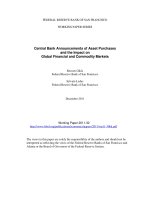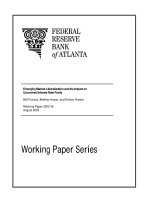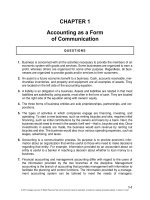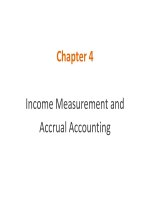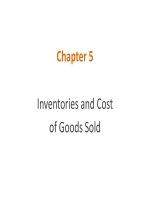Financial accounting the impact on decision makers 9e chapter 2
Bạn đang xem bản rút gọn của tài liệu. Xem và tải ngay bản đầy đủ của tài liệu tại đây (2.16 MB, 37 trang )
Chapter 2
Financial Statements and
the Annual Report
Objectives of Financial Reporting
Provide
useful information to those who must
make financial decisions
Balance sheet—assets, liabilities, and equity
Income statement—revenues and expenses
Statement of cash flows—cash flows from
operating, investing, and financing activities
Notes—accounting policies
LO 1
Example 2.1—Using Financial Reporting
Objectives to Make Investment Decisions
Qualitative Characteristics of
Accounting Information
Understandability:
the quality of accounting
information that makes it comprehensible to
those willing to spend the necessary time
Relevance: the capacity of information to make
a difference in a decision
Faithful representation: the quality of
information that makes it complete, neutral,
and free from error
LO 2
Qualitative Characteristics of
Accounting Information (continued)
Comparability:
for accounting information, the
quality that allows a user to analyze two or
more companies and look for similarities and
differences
Consistency: for accounting information, the
quality that allows a user to compare two or
more accounting periods for a single company
Qualitative Characteristics of
Accounting Information (continued)
Materiality:
the magnitude of an accounting
information omission or misstatement that will
affect the judgment of someone relying on the
information
Conservatism: the practice of using the least
optimistic estimate when two estimates of
amounts are about equally likely
Classified Balance Sheet
Separates
both assets and liabilities into current
and noncurrent
Current assets
Noncurrent assets
Current liabilities
Long-term liabilities
Stockholders’ equity
LO 3
Operating Cycle
Period
of time between the purchase of
inventory and the collection of any receivable
from the sale of the inventory
Operating Cycle (continued)
Current Assets
Expected
to be realized in cash, sold or
consumed within one year or operating cycle
Example: cash, marketable securities, accounts
receivable, merchandise inventory, prepaid
insurance, store supplies, etc.
Example—Current Assets Section
Noncurrent or Long-term Assets
Other than
the definition of current asset
Three common categories:
Investments: securities not expected to be sold
within the next year
Property, plant, and equipment: tangible,
productive assets used in the operation of a
business
Intangibles: lack physical substance
• Example: trademarks, copyrights, franchise rights, patents,
and goodwill
Example—Noncurrent or Long-term
Assets Section
Current Liabilities
Obligation
that will be satisfied within one year
or an operating cycle
Example: accounts payable, salaries and wages
payable, income taxes payable, interest
payable, bank loan payable
Example—Current Liabilities Section
Long-Term Liabilities
Obligation
that will not be paid within the next
year or an operating cycle, whichever is longer
Example: notes payable and bonds payable
Example—Long-term Liabilities Section
Stockholders’ Equity
Owners
claims on assets of the business
Arise from two sources:
Contributed capital
Capital
stock: owner’s investments in business
Paid-in capital in excess of par value
Retained earnings: accumulated earnings,
or net
income, of the business since its inception less all
dividends paid during that time
Example—Stockholders’ Equity Section
Example 2-4 Preparing a Classified
Balance Sheet
Example 2-4 Preparing a Classified
Balance Sheet (continued)
Analysis of Liquidity
Liquidity: ability
Working
to pay debts as they come due
capital
Current
assets − current liabilities
Negative working capital may signal the inability to
pay creditors on a timely basis
Current
liquidity
Ratio: higher ratio indicates high
Current Assets
Current Ratio =
Current Liabilities
LO 4
Example 2.5—Computing the
Current Ratio
The following formula shows that Dixon Sporting Goods
has a current ratio of just under 2 to 1:
The Income Statement
Summarizes the results of operations of an entity
for a period of time
Reports the excess of revenue over expense—that
is the net income
Single-step income statement: expenses are added
together and subtracted from all revenues in single
step
Multiple-step income statement: shows
classifications of revenues and expenses as well as
important subtotals
LO 5
Example 2.6—Preparing a Single-Step
Income Statement
Example 2.7—Preparing a MultipleStep Income Statement
